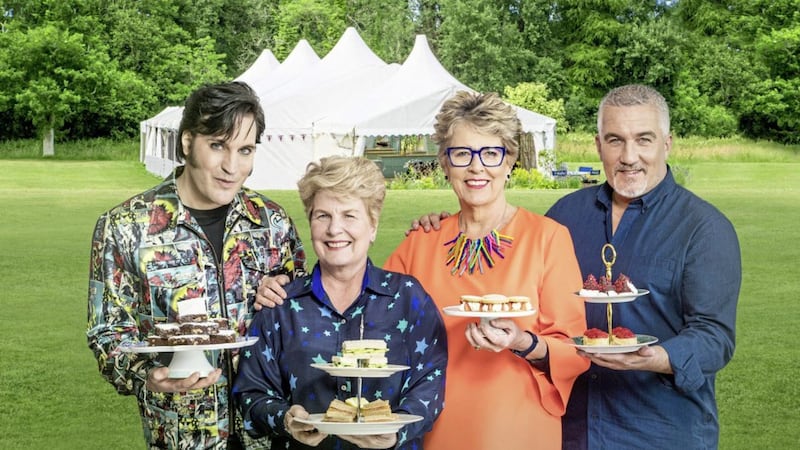WE'RE always told that baking is a bit of a science (which was never my forte at school). Over-mix your batter and your child's birthday cake might not rise, under-knead your bread and it'll end up dense and tough, miss-measure anything and it'll be a huge disaster. So it's no wonder baking can seem kind of intimidating.
I cook, of course, but home-made cakes, biscuits, pastry and bread is something I've always steered well clear of. Yet with each year of Great British Bake Off contestants mixing, kneading and proofing to create impressive masterpieces, I'm tempted to give it a go too (the basics, not a giant colourful dragon in biscuit form).
So, for the first time, I'm going to bake a cake – and then see where this baking pursuit takes me. Great British Bake Off 2020 watch out...
:: Lemon drizzle
I start by seeking out the simplest-looking cake recipe on the planet – butter, sugar, eggs, flour, baking powder and lemon zest, from the Great British Book Of Baking – what could go wrong? I borrow a cake tin and a handheld whisk (I own no relevant equipment whatsoever) and on a Sunday afternoon, I meticulously measure out all the ingredients (it's a science).
It turns out, bringing it all together with an electric whisk is weirdly exciting, and I pour it all into the cake tin, transfer to the oven, make the sticky lemony glaze – sugar, lemon juice and more zest – as instructed, and wait.
And then I get distracted and completely forget about it. I finally remember it's in the oven 20 minutes after the instructions call for removing it. In situations like this you can only laugh, my poor lemon cake looking uncharacteristically brown on top as I prod it and pour over the glaze.
After cooling, it's a little hard around the outside, crusty on top, and all in all a bit drier than the desired result, but it – and this is the important bit – does bear some resemble to a lemon drizzle cake. Despite over-baking Prue Leith definitely wouldn't approve of, it still feels vaguely satisfying to have turned flour, sugar and eggs into something (somewhat) edible.
:: Quiche
Call it overconfidence, but next I decide to cook lunch for my family involving homemade pastry. A basic shortcrust is made of flour and half fat (thanks, Delia), a pinch of salt and a dash of water, it should be crumbly and buttery, and years of watching Bake Off has drilled into me that there must not be a soggy bottom.
You don't want to overwork shortcrust, so the less you do the better (suits me). I discover it's literally a case working the butter into the flour – weirdly therapeutic – to create an even texture throughout, and using a tiny amount of water to bring the mixture into a ball that cleans the bowl. It's surprisingly easy. I rest it in the fridge for 30 minutes in cling-film, before rolling out (I have a rolling pin for this one) just larger than my quiche tin – it's looking a little thin but I go with it.
I copy what they all do on Bake Off: Draping the pastry over the rolling pin, to hover it over the tin and lower it into place. Next, I push it into the edges carefully, prick the bottom with a fork and blind bake for 15 minutes. I chop up my quiche filling – I'm going for broccoli, Stilton, walnuts and red onion – and whizz up a basic egg and cream mixture with some garlic and lemon zest.
The pastry comes out of the oven looking remarkably like pastry. I assemble my ingredients in the (slightly rustic-looking) case, pour in the egg mix before it goes back into the oven for 30 minutes. I suspect it may be down to Delia but the quiche, particularly the pastry, crumbly with a crisp bottom, is bloody delicious. Despite waiting until 4pm for lunch, my quiche recipients are impressed.
:: Raspberry and coconut (vegan) cake
I'm really pushing the boat out now, and attempt a dairy-free cake – nope, not even the absence of all-important eggs can stop my new baking prowess. I'm attempting a Tom Kerridge recipe, using coconut milk and mashed banana, desiccated coconut and lemon, along with self-raising flour, sugar and baking powder. Measuring and whisking before carefully folding some raspberries through the mixture to avoid knocking too much air out of it (I hear that's important).
I pile it into a loaf tin (borrowed, of course) and into the oven, while I make an icing from fresh raspberries, lemon juice and icing sugar. Some 40 minutes later, thrilled my cake has risen and firmed up on top, it's time to rest and cool it. Baking takes some patience; as Bake Off tells us, cakes need to cool before you ice them – and I probably don't wait quite long enough because most of the icing falls down the sides, but I artfully sprinkle fresh raspberries and toasted hazelnuts across the top.
The result is more pudding-y than spongy, but it's moist, tasty and a hit with all my (vegan and non-vegan) guests.
:: Will I be baking again?
I won't be whipping up batter on a weeknight anytime soon, but I found spending a few hours on a Sunday baking surprisingly relaxing and therapeutic.
There's something special about baking that feels as if you're making something out of nothing. And fresh out of the oven, even my beginner bakes (lemon drizzle aside) tasted better than most basic shop-bought ones, which is pretty satisfying. Plus, once you've got the basics in your cupboard, you can make so many things without needing a big supermarket trip.
CHOCOLATE AND ORANGE MARBLED LOAF CAKE
(Serves 6-8)
Oil, to grease
2 small oranges
170g butter, softened
170g caster sugar
3 eggs, at room temperature
170g self-raising flour
1-2tbsp water or milk
1tbsp good quality cocoa powder
A few drops of vanilla extract
Method:
Heat the oven to 180C/gas mark 4. Lightly oil the tin and line the base and short sides with a strip of greaseproof paper. Lightly oil the paper.Finely grate the zest of both oranges and set aside.
In a medium bowl, cream the butter and sugar together using an electric whisk or wooden spoon until pale, light and fluffy. Break the eggs into a small bowl and beat lightly, using a fork, until broken up. Gradually add the egg to the creamed mixture, in several additions, beating well after each addition.
Sift over the flour and fold it in, using a metal spoon or a spatula. If necessary, fold in enough water or milk to give a dropping consistency. Divide the mixture between two bowls and sift the cocoa powder into the first, mixing it through evenly. Stir the vanilla and orange zest into the second mixture.
Spoon some of each flavoured mixture into the bottom of the tin, layering them alternately. Once all the mixture is in the tin, use the handle of a teaspoon to make two or three swirls through the mixture, to create the marbling effect.
Bake in the oven for 50-60 minutes until a skewer inserted into the centre comes out clean. Remove from the oven and leave the cake to cool in the tin for 10 minutes before removing to a wire rack. Remove the lining paper and leave to cool completely.
LEMON MERINGUE CAKE
(Serves 8-10)
Oil, to grease
1 lemon
225g butter, softened
225g caster sugar
4 eggs, at room temperature
225g self-raising flour
1-2tbsp milk
For the lemon curd:
2 lemons
120g caster sugar
50g unsalted butter
2 eggs
For the meringue:
2 egg whites, about 60g
110g caster sugar
Method:
To make the lemon curd, finely grate the zest of both lemons and squeeze the juice. Put the juice in a saucepan with the sugar and butter. Beat the eggs in a small bowl and add them to the pan.
Stir the mixture over a low to medium heat, using a wooden spoon, until the butter and sugar have melted; increase the heat until the curd just starts to bubble. Remove from heat and strain through a sieve. Stir in the lemon zest and cover with cling film, so that it touches the surface of the curd to prevent a skin from forming. The curd will thicken as it cools.
Heat the oven to 180C/gas mark 4. Lightly oil two sandwich tins, line the base of each with a disc of greaseproof paper, then lightly brush with oil again. Finely grate the lemon zest.
Using an electric whisk, cream the butter and sugar together in a medium bowl until pale, light and fluffy.
Break the eggs into a separate bowl and beat lightly with a fork. Gradually add the eggs to the creamed mixture, beating well.
Sift the flour over the creamed mixture and add the lemon zest. Fold in the dry ingredients, using a large metal spoon until the mixture is just combined. Add enough milk to create a reluctant dropping consistency.
Divide the mixture between the tins, smooth the tops and bake in the middle of the oven for 20-30 minutes. The cakes should feel spongy to the touch. Leave them in the tins on a wire rack for a few minutes, then turn out on to the wire rack, peel off the greaseproof paper and leave to cool completely.
For the meringue, put the egg whites into a clean bowl and whisk to stiff peaks. Add one tablespoon of sugar and continue to whisk for 10 seconds, add a second tablespoon and whisk to stiff peaks again. Slowly pour in the remaining sugar, whisking at the same time.
Heat the grill to its highest setting. Sandwich the two cooled sponges together with the cold lemon curd. Decorate the top of the cake with the meringue, either piping it or swirling it over the surface with a palette knife.
To finish, place under the hot grill until the top browns.
:: This week's recipes are from Leiths How To Cook Cakes by Leiths School of Food and Wine, photography by Peter Cassidy, published by Quadrille, priced £12.99.




